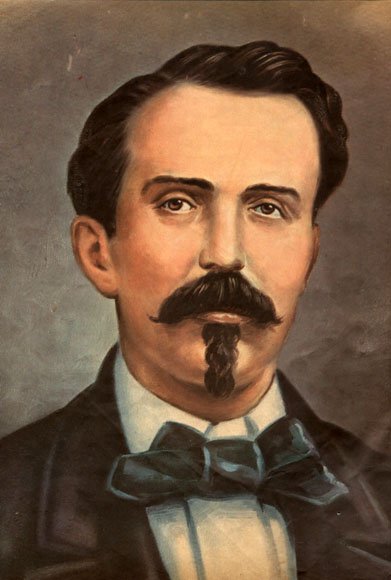<Back to Index>
- Explorer Count Ardito Desio, 1897
- Playwright Thomas Middleton, 1580
- Cuban Revolutionary Carlos Manuel de Céspedes del Castillo, 1819
PAGE SPONSOR

Carlos Manuel de Céspedes del Castillo (April 18, 1819 Bayamo, Oriente – February, 1874 San Lorenzo, Oriente) was a Cuban planter who freed his slaves, and made the declaration of Cuban independence in 1868 which started the Ten Years' War.
Céspedes was a landowner and lawyer in eastern Cuba, near Bayamo, who purchased La Demajagua, an estate with a tobacco plantation, in 1844 after returning from Spain. On October 10, 1868, he made the Grito de Yara (Cry of Yara), declaring Cuban independence, which began the Ten Years' War. That morning, after sounding the slave bell that indicated to his slaves it was time for work, they stood before him waiting for orders, and Cespedes announced they were all free men, and were invited to join him and his fellow conspirators in war against the Spanish government of Cuba. For this, he is called Padre de la Patria (Father of the Country). In April 1869 he was chosen President of the Republic of Cuba in Arms.
The Ten Years' War was the first serious attempt to achieve independence from Spain, and to free all slaves. The war was fought between two groups. In the East of Cuba the tobacco planters and farmers, joined by mulattos and some slaves, fought against the West of Cuba, with its sugarcane plantations (which required many slaves) and the forces of the Spanish Governor General. Hugh Thomas summarises thus: The war was a conflict between criollos (creoles, born in Cuba) and peninsulares (recent immigrants from Spain). The Spanish forces and the peninsulares, backed by rich Spanish merchants, were at first on the defensive, but in the longer run their greater resources told.
Céspedes
was
deposed in 1873 in a leadership coup. Spanish troops killed him in
February 1874 in a mountain refuge, as the new Cuban government would
not let him go into exile and denied him an escort. The war ended in
1878 with the Pact
of
Zanjón. The pact did make concessions: liberation of all
slaves and Chinese who had fought with the
rebels, no action for political offences; but not freedom for all
slaves, and no independence. The Grita
de
Yara had
achieved something, though not enough; but it had lit a long-burning
fuse. Lessons learned there were later put to good use in the Cuban
War
of Independence. Céspedes
was
married twice. The first to Maria del Carmen de Cespedes y del
Castilo and they had Maria del Carmen, Oscar, and Carlos Manuel de
Cespedes y Cespedes. He married the second time to Ana Maria de Quesada
y Loinaz (1842 – 1910) and they had 3 children, Gloria (1871 – ?), Oscar and Carlos
Manuel
de Céspedes y Quesada (1871 – 1939),
who was briefly President of
Cuba after Gerardo
Machado was deposed
in 1933. In San Lorenzo before he died, Carlos Manuel met a widow,
Francisca (Panchita) Rodriguez. Carlos Manuel and Panchita became
lovers and produced a son, Manuel Francisco de Cespedes y Rodriguez. He named
Oscar, his fifth son, after his late second child Oscar, who was shot
by a Spanish firing squad. The Spanish authorities wanted to exchange
Oscar's life for Cespedes' resignation as President of the Republic of
Cuba. He famously answered that Oscar was not his only son, because
every Cuban who had died for the revolution he started, was also his
son. He had
been, before the conflict, something of a musician, and he was
part-composer of a romantic song called La Bayamesa. His
portrait was on the 10 pesos bills in Cuba until 1960 when it was moved
to the 100 pesos bill. A municipality in Camagüey
Province, Carlos
M.
de Cespedes was
named after him.